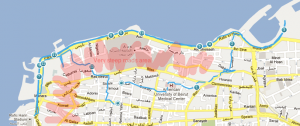It was nice move to have Beirut on early March work schedule, when the winter was still keeping Europe in tight grasp. For most people Lebanon means danger: neighbor Syria continues crackdown on uprising or the other neighbor Israel that has overran Lebanon couple times in last three decades. For me the chance to feel a place connecting west and middle east cultures, to taste famous cuisine and witness scars of modern military conflicts.
From the air Beirut looked amazing, concrete jungle stepping into the sea. Going from the airport to my hotel in city center I could see how chaos matches with peace. An architecture of buildings and roads badly maintained, the lack of expected western style finishing and creative way of driving cars was in contrast with couples and families walking at the sea shore during the sunset as well as crowded coffee houses and restaurants.
From closer view a perceptive observer can find signs of military conflicts in virtually every place. Lazy observer can even find buildings in downtown looking like shooting range, with holes on every facet. Most of them are covered with patches of slightly different painting color, signs of plastic surgery: plasters applied on holes and then repainted. I have already seen a lot of war traces in Bosnia and Croatia yet in Beirut all these marks were melted into the city landscape making it more disturbing.
The obvious evidence of tension in the region I found next to the parliament: the barber wires separating house of ministry from the street due to successful assassination of former prime minister in 2005 by Hezbollah (or Israelis, depending on viewpoint). Soldiers with rifles deployed here and there, barricades and watchtowers, all that to keep an eye on strategic buildings and living houses of officials and reach people.
On the other hand I faced great hospitality of locals. It started from very kind support in hotel, I would say unusual because very natural. It was important in my situation as my luggage was lost and I need to survive first day somehow. The group of IT people I was working with was also engaged, they guided me through the city and food in close restaurant, as well I got offer to come back for longer stay and even more extensive guidance (Moneef, Ahmad, definitely I will be back).
Even though I was there just three days I had to do at least three things – look around to get city impressions, check out Lebanese food in local restaurants and as always, skate through the city.
Lebanese food matches my profile: a lot of vegatables in it, very intense and tasteful seasonings, all these combined with meat in good proportion. Starting from Hommos (classic arabic starter I love the most) through Fattush and Tabbuleh salads to dishes I could not memorize trying it first time. I realized it is even harder as the tradition splits a meal into couple phases each one having set of typical names on its own; so to start with “cold mezza” and “hot mezza” (starters), through main course to deserts, usually every step mandatory. No wonder that typical meal takes 2-3 hours if you mix in also a lot of chats and fun with friends or family. Even local fast foods turned to be excellent. I have been to a place on Hamra street that foreigners were simply passing by, looked cheap and scruffy yet I found fresh ingredients in burger I ordered. Not only they used fresh vegetables and home-made sauces and fresh fries of potato taste, also the meat was prepared and cooked on demand.
Skating was the last item on checklist. First time to Beirut could not be excuse for my “skating the world” plan I am running for more than a year now. I was thrilled a bit after I have seen careless drivers on steep cracked roads, downhill in Ankara (no fun) came back to my mind. Even though the city center is easy to skate as it is only a little hilly and slanted towards the east (from Hamra to parliament), I was trying to get from my hotel directly to Cornishe where best pathwalks are located. This way I could avoid Ankara syndrome i.e. short ride full of struggling and badly worn wheels on constant breaking. Problem was that last quarter of mile away from coastline has elevation with angle exceeding 30 degrees, long straight streets with cars parked both sides, and cracked sandy tarmac – a nightmare for street skater. Simple raid down the street would be asking for trouble as there was neither way to break nor jump away in emergency. I decided to combine my route: to go east-north looking for less declined roads and on the way back climb up shortest way. Finally it was worth it; the north part of Corniche has more than 4km of wide, smooth and flat sidewalk. Pity was that south-east part of Corniche is separated from the other north part by sand path and highway.
Beirut had opened the skating season 2013, even though the rush begun 6 weeks after my trip to Lebanon. As soon as temperatures jumped up from near-zero to nearly 20 degrees in just couple days, snow melted completely and streets and sidewalks dried out, I exploded. Despite massive sand patches and dust covering most of tracks I did 100km urban routes in just one last week, which was more than 10% of total skating distance from 2012! End of story, time to go outside.






























